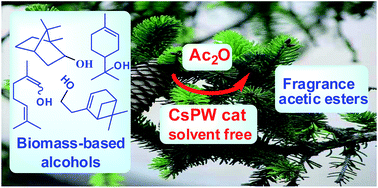Heteropoly acid catalysts for the synthesis of fragrance compounds from bio-renewables: acetylation of nopol and terpenic alcohols†
Abstract
The cesium salt of tungstophosphoric heteropoly acid, Cs2.5H0.5PW12O40, is an active and environmentally friendly heterogeneous catalyst for the liquid-phase acetylation of nopol and several biomass-derived terpenic alcohols (i.e., α-terpineol, nerol, geraniol, linalool, menthol, isoborneol, perillyl alcohol, carveol, isopulegol, carvacrol and nerolidol) with acetic anhydride. The resulting flavor and fragrance acetic esters, which are widely used in perfumery, household and food products, are obtained in good to excellent yields. The reactions occur at room temperature with low catalyst loadings without substantial catalyst leaching and can be performed with stoichiometric amounts of an acetylating agent in solvent free systems.

- This article is part of the themed collection: SBQ-RSC: Celebrating UK-Brazil collaborations

 Please wait while we load your content...
Please wait while we load your content...